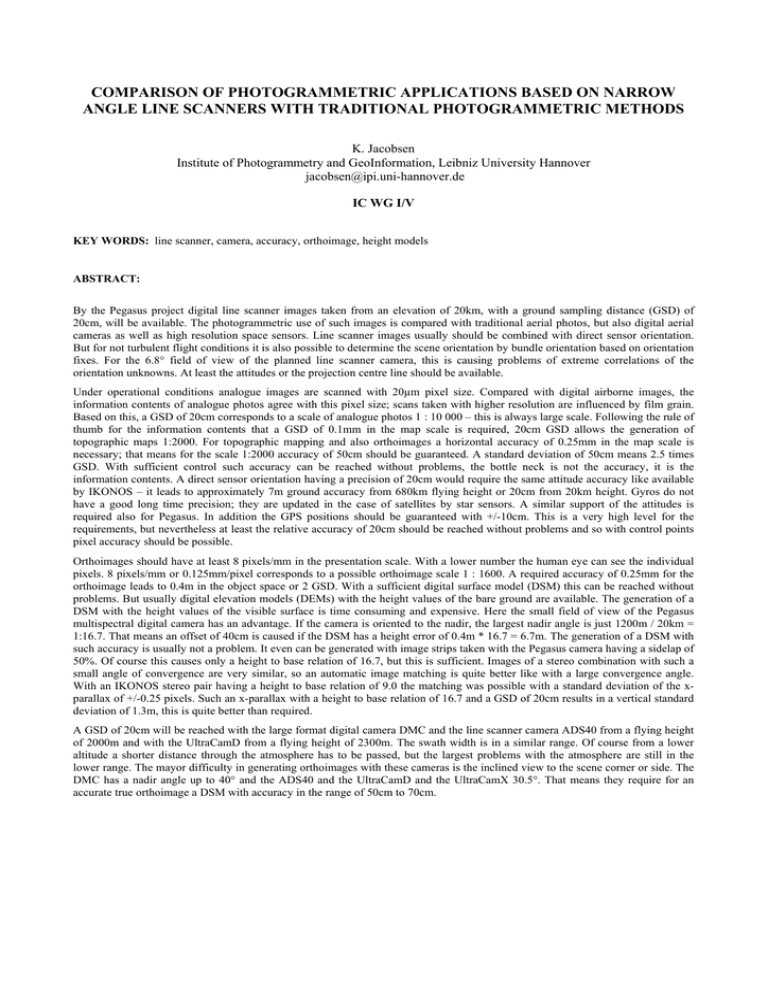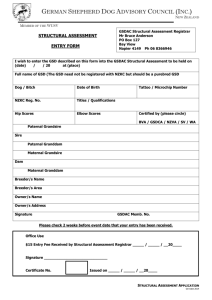COMPARISON OF PHOTOGRAMMETRIC APPLICATIONS BASED ON NARROW
advertisement

COMPARISON OF PHOTOGRAMMETRIC APPLICATIONS BASED ON NARROW ANGLE LINE SCANNERS WITH TRADITIONAL PHOTOGRAMMETRIC METHODS K. Jacobsen Institute of Photogrammetry and GeoInformation, Leibniz University Hannover jacobsen@ipi.uni-hannover.de IC WG I/V KEY WORDS: line scanner, camera, accuracy, orthoimage, height models ABSTRACT: By the Pegasus project digital line scanner images taken from an elevation of 20km, with a ground sampling distance (GSD) of 20cm, will be available. The photogrammetric use of such images is compared with traditional aerial photos, but also digital aerial cameras as well as high resolution space sensors. Line scanner images usually should be combined with direct sensor orientation. But for not turbulent flight conditions it is also possible to determine the scene orientation by bundle orientation based on orientation fixes. For the 6.8° field of view of the planned line scanner camera, this is causing problems of extreme correlations of the orientation unknowns. At least the attitudes or the projection centre line should be available. Under operational conditions analogue images are scanned with 20µm pixel size. Compared with digital airborne images, the information contents of analogue photos agree with this pixel size; scans taken with higher resolution are influenced by film grain. Based on this, a GSD of 20cm corresponds to a scale of analogue photos 1 : 10 000 – this is always large scale. Following the rule of thumb for the information contents that a GSD of 0.1mm in the map scale is required, 20cm GSD allows the generation of topographic maps 1:2000. For topographic mapping and also orthoimages a horizontal accuracy of 0.25mm in the map scale is necessary; that means for the scale 1:2000 accuracy of 50cm should be guaranteed. A standard deviation of 50cm means 2.5 times GSD. With sufficient control such accuracy can be reached without problems, the bottle neck is not the accuracy, it is the information contents. A direct sensor orientation having a precision of 20cm would require the same attitude accuracy like available by IKONOS – it leads to approximately 7m ground accuracy from 680km flying height or 20cm from 20km height. Gyros do not have a good long time precision; they are updated in the case of satellites by star sensors. A similar support of the attitudes is required also for Pegasus. In addition the GPS positions should be guaranteed with +/-10cm. This is a very high level for the requirements, but nevertheless at least the relative accuracy of 20cm should be reached without problems and so with control points pixel accuracy should be possible. Orthoimages should have at least 8 pixels/mm in the presentation scale. With a lower number the human eye can see the individual pixels. 8 pixels/mm or 0.125mm/pixel corresponds to a possible orthoimage scale 1 : 1600. A required accuracy of 0.25mm for the orthoimage leads to 0.4m in the object space or 2 GSD. With a sufficient digital surface model (DSM) this can be reached without problems. But usually digital elevation models (DEMs) with the height values of the bare ground are available. The generation of a DSM with the height values of the visible surface is time consuming and expensive. Here the small field of view of the Pegasus multispectral digital camera has an advantage. If the camera is oriented to the nadir, the largest nadir angle is just 1200m / 20km = 1:16.7. That means an offset of 40cm is caused if the DSM has a height error of 0.4m * 16.7 = 6.7m. The generation of a DSM with such accuracy is usually not a problem. It even can be generated with image strips taken with the Pegasus camera having a sidelap of 50%. Of course this causes only a height to base relation of 16.7, but this is sufficient. Images of a stereo combination with such a small angle of convergence are very similar, so an automatic image matching is quite better like with a large convergence angle. With an IKONOS stereo pair having a height to base relation of 9.0 the matching was possible with a standard deviation of the xparallax of +/-0.25 pixels. Such an x-parallax with a height to base relation of 16.7 and a GSD of 20cm results in a vertical standard deviation of 1.3m, this is quite better than required. A GSD of 20cm will be reached with the large format digital camera DMC and the line scanner camera ADS40 from a flying height of 2000m and with the UltraCamD from a flying height of 2300m. The swath width is in a similar range. Of course from a lower altitude a shorter distance through the atmosphere has to be passed, but the largest problems with the atmosphere are still in the lower range. The mayor difficulty in generating orthoimages with these cameras is the inclined view to the scene corner or side. The DMC has a nadir angle up to 40° and the ADS40 and the UltraCamD and the UltraCamX 30.5°. That means they require for an accurate true orthoimage a DSM with accuracy in the range of 50cm to 70cm. 1. INTRODUCTION Unmanned Aerial Vehicles (UAV) are used more and more for civilian remote sensing purposes. The High Altitude Long Endurance (HALE) UAV is closing the gap between aerial and space data acquisition. HALE UAV may be for long time in permanent use, leading to a high imaging capacity of the multispectral digital camera. 20cm GSD corresponds to analogue aerial images with a scale of 1 : 10 000 under the condition of the operational scan with 20µm pixel size. Such ground resolution always belongs to large scale. In 2007 from space for civilian application 41cm GSD will be available by the planned GeoEye-1 and 45cm by WorldView-1 and -2; but this is still a factor of 2 less than planned for the Pegasus project. In addition the investment for Pegasus is quite below the investment for very high resolution satellites. The field of view (FOV) for the multispectral digital camera of Pegasus with 6.8° is within between the high resolution satellites having 1° up to 2.2° and narrow angle analogue cameras with 41°. This is causing some geometric problems, unusual for standard photogrammetry. The planned ground accuracy below a pixel may be difficult to be achieved. Compared to very high resolution space sensors based on the attitudes it corresponds to 6.8m for 680km flying height of IKONOS or 4.5m for 450km flying height of QuickBird. IKONOS is reaching this, but not QuickBird. Of course it is influenced by the dynamic imaging of the satellites with permanent change of the view direction, but it shows that a positional accuracy of 20cm from a flying height of 20km may be difficult without control points. With control points it should not be a problem, but sub-pixel accuracy always is only possible with well defined points. 2. IMAGE ORIENTATION The image orientation of classical analogue photos as well as for digital frame cameras, traditional is determined by bundle block adjustment using image and ground coordinates. Today the projection centres can be determined by relative kinematic GPS positioning reducing the number of required control points for the bundle block adjustment. But also the attitudes can be achieved by a combination of giros and GPS observation leading to direct sensor orientation which only needs a calibration with control points and is independent upon ground control based on this information. Under operational conditions for the usual flying heights below 6km a standard deviation of the ground coordinates of 20cm can be reached without ground control. The direct sensor orientation is operational even if it is not used in a high percentage. Care has to be taken for the support of the attitude by GPS observation because the giros do not have sufficient long time accuracy. In aerial application some control figures like the form of an eight have to be flown to guarantee the relation between the giro information and the GPS positions. The satellites are equipped with star cameras for the attitude drift control. Line scanner images should be supported by additional information since any CCD-line has a different orientation. Of course neighboured CCD-lines are strongly correlated allowing also the orientation just based on a higher number of control points if the imaging conditions are not too turbulent. The use of a higher number of control points is not an economic solution, so the additional orientation information should be used. Satellite images are not influenced by turbulences and the limited scene size allows also an orientation with a smaller number of control points. With the direct sensor orientation the number of control points for example for IKONOS scenes can be reduced just to 1 without loss of accuracy while methods not using existing orientation information like the 3D affine transformation should use at least 4 control points (Jacobsen 2006). The attitude and position information has to be calibrated in relation to the sensor – named also boresight misalignment determination. The boresight misalignment should be based on control points; it includes the attitude and position location of all used sensors including also time synchronisation. In the flight direction the attitude (pitch) cannot be separated from the position in the flight line including the antenna offset, but the antenna offset can be measured without problems before start and is not changing. The synchronisation error can be computed based on a flight with opposite direction. For roll and yaw control points are required. The roll and yaw determination has been investigated based on simulated data not using additional information. roll pitch yaw Y0 Z0 roll 1.0000 .1700 .0135 .9994 -.2338 pitch .1700 1.000 .0084 .1698 -.0029 yaw .0135 .0084 1.000 .0659 -.0068 Y0 .9994 .1698 .0659 1.000 .2333 Z0 -.2338 .0029 -.0068 .2333 1.000 Table 1: correlation of scene orientation elements FOV = 6.8° Caused by the small view angle roll and the coordinate across the flight direction are correlated by r=0.9994 (table 1). The correlation is only slightly dependent upon the number of points used for the calibration. Influenced by the correlation, the standard deviation of the projection centre component across flight direction is quite above 20cm (figure 1), but a discrepancy in the projection centre is compensated by the attitude. A separation of the error components is partially possible with opposite flight direction. Another possibility for the separation of the unknowns is the calibration in different flying elevations. Fig. 1: dependency of projection centre standard deviation for coordinate X0 from number of control points based on a standard deviation of unit weight of 0.66 pixels The flying height Z0 is not strongly correlated with the other orientation unknowns, so its standard deviation is not influenced by this. It is just between 1.3cm for 114 control points and 13cm for 7 control points. Because of the small view angle, the height is also not very critical to ground point positions. The Pegasus multispectral digital camera has with the 6.8° FOV optimal conditions for the generation of orthoimages. Based on vertical view, the maximal tilt of view is just 1 : 17. Even if an error in the projection centre of 2m exists, compensated on the control point level by attitudes, for a location with 200m difference in height against the control point level, the resulting problem in the ground position is just 2cm. The described orientation problem is typical for small angle line scanner images. It exists even with more problems for the very small angle satellite line scanner images. From space there is only the advantage of a more simple support of the giro information by star cameras, but this also requires one more required relation of the sensor constellation. A precise calibration is very time consuming and has to be made by means of test fields with a higher number of control points located in different height levels. In addition images taken with different nadir angles are necessary. Because of the large field of view for aerial frame images the calibration is simpler. The camera geometry can be adjusted by self calibration with additional parameters. If a direct sensor orientation shall be included, the boresight misalignment can be determined with a small test field with just few control points and flight lines taken in opposite direction. 3. SENSOR OVERVIEW Alternative data acquisition can be made with the traditional analogue aerial cameras, but also the new digital frame cameras, digital line scanner and space images. The analogue aerial cameras are replaced more and more by digital cameras. As large format digital frame cameras Intergraph DMC and Microsoft-Vexcel UltraCamD and UltraCamX are available. With such cameras a GSD down to 3cm can be reached but of course with just a small swath width. The usual endlap of 60% guarantees a sufficient height to base relation with a height to base relation of 3.2 for the DMC and 3.7 for both Vexcel cameras (table 3). The height to base relation is nearly identical to the relation of the vertical to the horizontal object accuracy. That means it is possible to reach up to 10cm vertical accuracy of object points. Intergraph DMC 120mm 12µm 7 680 Vexcel UltraCamD 100mm 9µm 7 500 Vexcel UltraCamX 100mm 7.2µm 9420 focal length pixel size pixel in flight direction pixel across 13 824 11 500 14430 flight direction Table 2: panchromatic channel of digital frame cameras height to base relation for endlap = 60% 1.6 tangent of nadir angle in image corner analogue wide angle camera analogue normal 3.3 angle camera Intergraph DMC 3.2 Vexcel UltraCam 3.7 Leica ADS40 1.2 Table 3: characteristics of aerial cameras 1 : 1.0 Across flight direction the number of pixels is not far away from the Pegasus multispectral camera (table 2), so with the same object pixel size a similar swath width will be reached. The resolution for the colour channel is smaller by the factor 4.6 for DMC and 3 for Vexcel reducing the possibility of object classification. Like the Pegasus multispectral camera, the Leica ASD40 is also a line scanner camera, having 12000 pixels. The staggered CCD-line combination with 2 lines, each with 12000 pixels shifted 0.5 pixel against each other, is not really effective, so in reality the information contents corresponds to 12000 pixels (Becker et al 2005). The ADS40 has to be combined with direct sensor orientation by giros and GPS. Under operational conditions the smallest object pixel size is 15cm – not far away from the Pegasus specification. The ADS40 in addition to the nadir view has also forward and a backward view, leading to a stereoscopic coverage in any case. The other side of the ground resolution is coming from the space sensors. Currently 7 civilian or dual use optical space sensors with GSD of 1m or below are in the orbit (table 4). More will come in near future, also some with even higher resolution (table 5). GSD [m] pan / ms 0.82 / 3.24 1.0 / -0.62 / 2.48 1 / 4 0.7 / -1 / 3 swath [km] IKONOS, USA 11 TES, India 15 QuickBird, USA 17 OrbView-3, USA 8 EROS-B1, Israel 7 Resourcesat DK-1, 28 Russia KOMPSAT-2, 1 / 4 15 South Korea Table 4: existing civilian or dual use very high resolution optical space sensors pan = panchromatic ms=multi spectral GSD [m] swath launch pan / ms [km] Cartosat-2, India 0.8 / -10 2006 WorldView-1, USA 0.45 / -16 2007 GeoEye-1, USA 0.41 / 1.6 15.2 2007 WorldView-2, USA 0.46 / 1.8 16.4 2008 Table 5: planned civilian or dual use very high resolution optical space sensors pan = panchromatic ms=multi spectral Caused by the larger GSD, the swath of the high resolution space images exceeds the swath of the multispectral Pegasus camera. The HALE UAV have the possibility to fly meandered over a larger area while the space systems do have a repetition rate of some days if also stronger inclined views are accepted. For lower nadir angle the repetition rate is quite higher, leading to a better possibility to cover an area by HALE UAVs. Also the financial situation has to be taken into account; the very high resolution satellites are still expensive, leading to expensive images. 1 : 1.9 4. ORTHOIMAGES AND MAPPING 1 : 1.3 1 : 1.6 1 : 1.6 As mentioned before, a very small tilt of view is optimal for orthoimages. For a sufficient image product orthoimages should have at least 8 pixel/mm in the representation scale. Below such a resolution the human eye can see the individual pixels. So with 20cm ground sampling distance (GSD) orthoimages up to the scale 1:1600 can be generated. In orthoimages and maps no standard deviation below 0.25mm is requested corresponding to 40cm or 2 GSD for the representation scale 1:1600. If the orientation guarantees a position accuracy of 20cm, for the influence caused by the height, with the usual error propagation 35cm positional error component can be accepted. With the maximum tilt of view 1 : 17 up to a standard deviation of 5.9m for the used digital elevation model (DEM) can be accepted. Such accuracy even with the free of charge available DEM from the shuttle radar topography mission (SRTM) (available via http://www2.jpl.nasa.gov/srtm/) is given for flat and rolling terrain (Sefercik, Jacobsen 2006). Another possibility is the generation of a DEM based on neighboured flight lines overlapping 50%. Of course this is leading to a poor height to base relation of 33 or an angle of convergence of just 1.7°. On the other hand automatic image matching with such a model results in a small standard deviation of the X-parallax (SPx) since the good similarity of the images. So a SPx of 0.3 pixels can be reached without problems corresponding to a standard deviation of the height model (SZ) of SZ = 2.2m. This is more accurate than required for the generation of orthoimages. Line mapping – that means today data acquisition for a GIS – under the given conditions usually will be made based on orthoimages. As rule of thumb 0.1mm GSD in the presentation scale is required, corresponding to a possible map scale 1 : 2000 for 0.2m GSD. Also in the map no higher accuracy than 0.25mm is required, that means for the scale 1 : 2000 a standard deviation of 50cm or 2.5 GSD. This can be reached in digital images without any problem if the orientation is guaranteed. The same rules of thumb for orthoimage generation and mapping exist for aerial and space images. For aerial frame cameras the tilt of the view direction is quite higher like for the Pegasus multispectral camera. The standard deviation of the ground heights determined by photogrammetry can be estimated by the height to base relation multiplied with the standard deviation of the x-parallax (SPX) in units of the GSD. For topographic points SPX is approximately identical to the GSD. This leads to ground height accuracies for 20cm GSD in the range of 24cm up to 74cm – quite more accurate like with the Pegasus multispectral camera, but the inclined view requires a quite more accurate DEM for the generation of orthoimages (basic information in table 5). For orthoimages 1 : 1600 made by means of aerial images with required error components based on the DEM of 35cm, like mentioned above, the DEM accuracy should not exceed 35cm divided by the tangent of the nadir angle in the image corner (table 5); that means between 35cm for wide angle cameras up to 66cm for normal angle cameras compared to 4.25m for the Pegasus multispectral camera. Very high resolution space images have a very small field of view, but usually the images are not taken with nadir view. Nadir angles up to 20° are usual, often also nadir angles up to 30° are accepted to reduce the repetition rate for imaging – this is required if also problems with cloud coverage exists and the imaging shall be possible within a tolerable time frame. Usually no imaging orders are accepted by the data distributors with a tolerance of the nadir angle less than 10°. That means the mapping has to be planned with a nadir angle of at least 10°. For the generation of orthoimages corresponding DEMs are required. With QuickBird images having 0.62m GSD orthoimages up to the presentation scale 1 : 5000 can be generated. Such a scale should not exceed 1.25m standard deviation. With 10° nadir angle the usable DEMs should have a standard deviation not exceeding 7m – this is even available with the SRTM height models. For 30° nadir angle the required DEM should not exceed accuracy above 2.2m – this is quite more difficult and not available free of charge. The number of close to nadir angle scenes in the image archives is still limited, making the orthoimage generation with space images more difficult. Of course by theory the very high resolution satellites are agile, allowing stereo coverage from the same orbit for the generation of DEMs, but this reduces the imaging capacity, so only few stereo scenes are available and it is difficult to place orders. Another possibility is the use of stereo satellites like Cartosat-1 for DEM determination. With Cartosat-1 stereo models standard deviations of Z in open and flat areas of 3m up to 4m are possible. With the same rule of thumb like mentioned before, with QuickBird images line maps up to the scale 1 : 6000 can be generated; with the coming 41cm and 45cm GSD of GeoEye-1 and WorldView we even can go to 1 : 4000, but with such a GSD not the object details required for mapping in 1 : 2000 can be identified. CONCLUSION HALE UAVs are offering a new possibility for remote sensing application, filling the gap between aerial and space data acquisition. They do have the advantage of a better availability over the area to be mapped. The competition against aerial cameras, today more and more to digital aerial cameras, has to be made with the financial aspect. In relation to the space data the resolution is quite better and this will not change in the near future. The small view angle together with the nadir view offers excellent conditions for orthoimage generation. Some new questions for the direct sensor orientation are raised by such systems especially caused by drift effects of the giros. The small field of view leads to strong correlation between the roll and the projection centre component across the flight direction. In the flight direction there is still a numerical dependency of the projection centre position to the pitch. This makes the calibration more complicate, but it is still possible. Of course like also for the geo-referenced space images for operational applications a minimum of control points will be used. REFERENCES Becker, S., Haala, N., Reulke, R., 2005: Determination and Resolution of Spatial for Digital Aerial Images, ISPRS Hannover Workshop, IntArchPhRS. Vol. XXXVI part I/W3 + http://www.ipi.uni-hannover.de/ under publication, workshops Jacobsen, K., 2006: Pros and cons of the Orientation of very high Resolution Optical Space Images, ISPRS Com I, Paris 2006, IntArchPhRS. Volume XXXVI Part I, on CD + http://www.ipi.uni-hannover.de/ under publication, 2006 Sefercik, U., Jacobsen, K.: Analysis of SRTM Height Models, 5th Turkish-German Geodetic Days, Berlin 2006, on CD, + http://www.ipi.uni-hannover.de/ under publication, 2006




